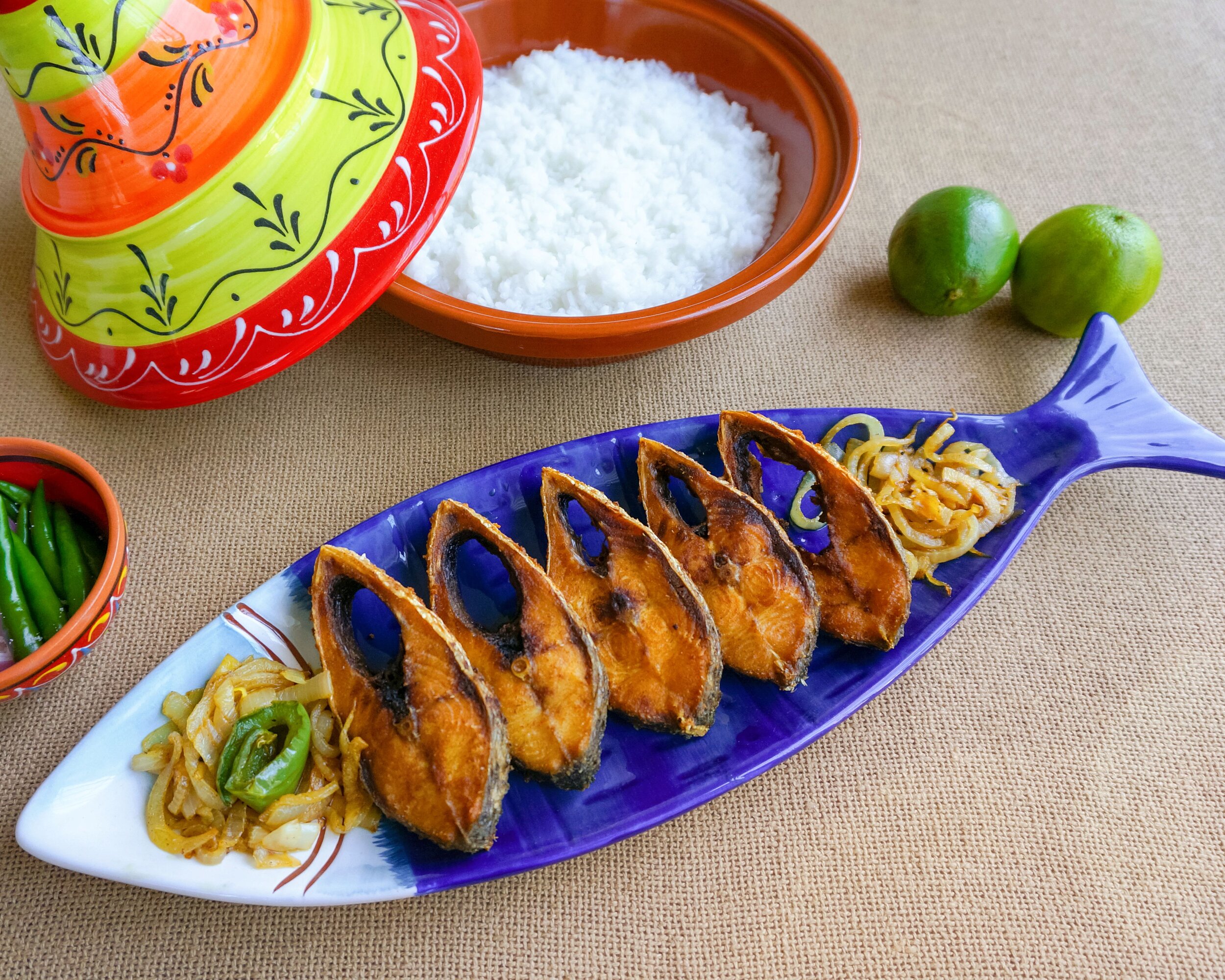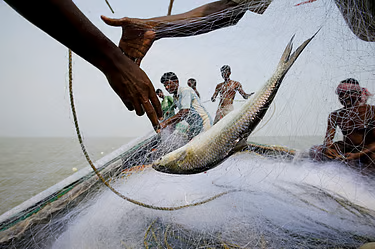As soon as Pahela Baishakh (the Bengali New Year) arrives, discussions about hilsa fish increase. Hilsa is a part of the Bengali tradition spanning hundreds of years- an integral element of this heritage. Hilsa with soaked rice (panta bhat), a slice of onion on the side, and a raw or dried chili- served on a clay plate- what an amazing combination! Perfect, at least for a photo!
But is panta-hilsa truly a part of Bengali heritage? If you believe that popularity equates to tradition, then yes, panta-hilsa may be considered a tradition. However, our tendency to turn anything into tradition is quite embarrassing.
Anyway, a while ago, I read a news article questioning whether this combination of panta rice and hilsa was really accessible to the common people in the past. Since I haven’t had the opportunity to research Bengali heritage myself, I’ll proceed by referring directly to that report.
Shamsuzzaman Khan, the Director General of the Bangla Academy, conducted long-term research on Bengali heritage. According to him, in earlier times, farmers could hardly afford hilsa. Even back then, hilsa was considered an expensive fish. And rightly so- it wasn’t available everywhere in Bangladesh, and catching it required great effort. Naturally, it was beyond the reach of common people, which explains its high price. According to Khan, since Baishakh is a month of drought and little harvest, farmers would have had very limited money. So, having a luxurious panta-hilsa meal during that time would’ve been out of the question.
So how did hilsa become a "tradition" then? Interestingly, it was suggested by a gentleman in the 1980s- and from there, it somehow turned into a "century-old tradition"!
The Bengali people are easily manipulated. One reason is ignorance, and another is the tendency not to question. Most of the time, we willingly allow ourselves to be manipulated- without anyone even trying very hard. Suppose someone presents an idea with some information or logic- we take that as a reference without thinking whether it’s true or not. And if that idea becomes popular, there’s no stopping it. That’s why even the criteria for being considered an intellectual in our society differs vastly from the rest of the world.
Let’s return to the main topic- hilsa. There’s a specific breeding season for hilsa. Considering that, the government issues restrictions on when hilsa can be caught and when it can’t. You’ve probably heard about "jatka" as well. Simply put, immature hilsa are called jatka. To let them grow to full size, from November 1 to June 30 every year, it is completely prohibited to catch, transport, store, or buy/sell hilsa. So, if you're eating hilsa on Pahela Baishakh- unless it’s last year’s frozen fish- you’re breaking the law.
In my opinion, hilsa is a political fish. If rice prices increase in Bangladesh, it's seen as a sign of inflation. But if hilsa catches go up, it's touted as a major success in the fisheries sector! Even though it’s not a farmable fish!
Think about it: if you run a poultry farm and produce more chickens, that’s agricultural success. If rice production increases year over year, that’s success. But if you're not actually producing fish and the number just "naturally" increases- is that real success?
Okay, it could still be called success- you could argue that better management led to increased production.
Here’s the funny part- such claims are actually made! Every year, the Department of Fisheries publishes a book titled Yearbook of Fisheries Statistics of Bangladesh. I was shocked to see that whenever hilsa is discussed, they just copy data straight from previous years’ reports- again and again! Just imagine!
And the summary of those reports? “Thanks to improved management, hilsa production has increased.”
But the joke doesn’t end there- they even provide statistics to prove hilsa growth. For example, in FY 2001–02, hilsa production was about 220,000 metric tons. In 2002–03, it dropped to about 199,000 metric tons. Sudden drop- strange, right? Honestly, the reason behind the drop is quite questionable.
Because after that year, hilsa production has never declined- only increased! In 2003–04: 256,000, next year: 276,000, then: 277,000 metric tons. This growth trend continues, and by FY 2022–23, it reached nearly 571,000 metric tons! Amazing! It increases every year- never decreases! Such obedient fish- can you believe it?
Keep those stats coming- if Allah wills, maybe I’ll witness 10 million metric tons of hilsa produced in my lifetime!
Honestly, I wouldn’t question this growth- if it weren’t used every year to take political credit by saying “hilsa production increased due to improved management.” On one hand, you claim better management, and on the other hand, there’s a flood of new nets and advanced fishing gear in the country!
In my view, if production increases, it's not because of stronger management- it's due to weak management! Let me explain.
Every environment has a carrying capacity- a limit on how many individuals of a species it can support. For example, if you raise chickens, your farm can only hold a certain number before they start dying or stop growing. You might slightly increase this limit with more feed, but there’s always a ceiling.
But in a natural environment, even that much control is not possible. And hilsa, like any species, needs food to grow, has natural predators, diseases, reproductive issues- you can't just flood the world with hilsa by wanting to.
In scientific terms, there's a concept called the logistic growth curve. Based on this, the Gordon-Schaefer Model in bioeconomics explains that a species- like hilsa- grows gradually in a habitat until the birth and death rates equalize, and the population stabilizes.
So, even if the number of hilsa doesn’t increase, your catch can still go up. How? You simply keep improving your fishing methods. Today you use regular nets; tomorrow, ‘current nets’. So, does this increased catch reflect better management- or worse?
And this kind of hilsa politics isn’t new in the world.
We already have a terrifying example- the British used to consume a lot of cod fish, mainly from the North Sea. From the 1970s to 1990s, technological advancements increased cod fishing, driving up prices. After all, if you invest in new gear, more people, better boats- you need a higher selling price to cover costs. Scientists warned that increasing catch numbers didn’t mean more fish- just more fishing. But politicians ignored them.
Eventually, the fish population collapsed, and so did the entire industry.
In recent years, haven’t you noticed the exponential increase in hilsa prices compared to other fish? Doesn’t it seem like we’re heading down the same path? Sadly, it feels like many departments in our country wait in line to validate such political narratives.



Post a Comment